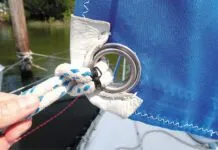Aries Source
I have a Seafarer 38 yawl with an Aries windvane self-steerer. The vane needs parts, some special bushings, bearings and so forth. I have been trying to locate a current parts source without success.
Are you up to the challenge of finding an Aries parts source?
Howard Weinstock
St. Thomas, Virgin Islands
Recently we heard that someone had bought Aries and moved it to one of the Scandinavian countries, but we havent been able to confirm this. Nor can Cruising Gear, which is a source of bushings and moving parts for the Aries. Cruising Gear, 2747 SW 27th Ave., Miami, FL 33133; 305/854-7600. e-mail: sailgear@icanect.net
Wiring 6-Volt Batteries
In previous issues you have discussed the use of 6-volt batteries in place of 12-volt batteries. Each year the 12-volt batteries get heavier. I have two batteries for my house bank. What is the correct way to connect the four 6-volt batteries?
Rick Noorman
Grand Rapids, Michigan
We think youve made a good decision switching to 6-volt batteries. We did this about four years ago and think it was one of the better decisions weve made regarding the boats systems.
The schematic shows the difference between parallel and series wiring. You want series wiring. On our boat, we have two banks, each consisting of two 6-volt batteries rated at about 215 amp-hours (there is no dedicated engine start battery; instead, we switch from one bank to the other each day). But if you want all four batteries to make up one 12-volt bank, then wire the two series-wired pairs in parallel.
Note in the example that two 105AH 12-volt batteries wired in parallel have the same capacity as the four 105AH 6-volt batteries. The advantage to using the 6-volt batteries is that each one would be much smaller than the 12-volt battery. If you buy a 6-volt battery of the same approximate size and weight as a 12-volt battery, it will have about twice the capacity, say, 210AH instead of 105AH. In the example, four 210AH 6-volt batteries would total 420AH.




































